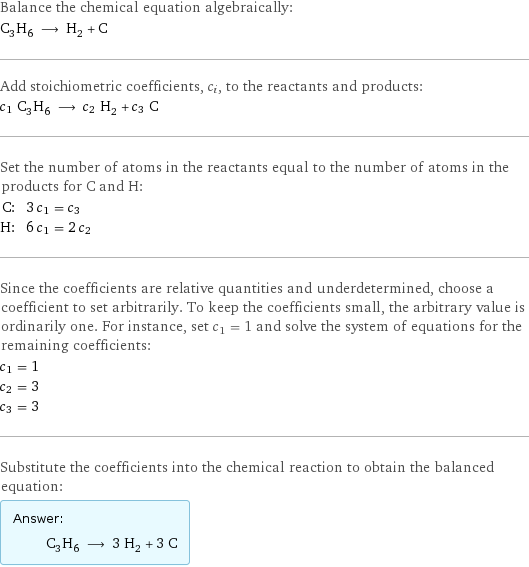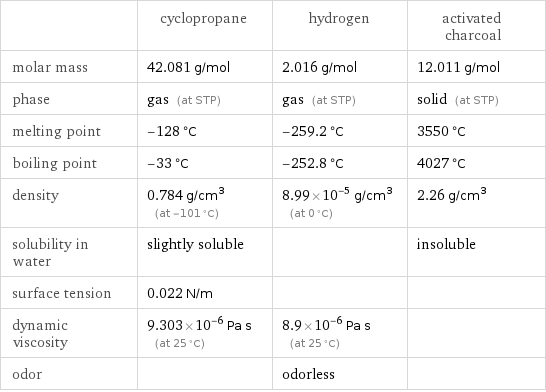Input interpretation

C_3H_6 cyclopropane ⟶ H_2 hydrogen + C activated charcoal
Balanced equation

Balance the chemical equation algebraically: C_3H_6 ⟶ H_2 + C Add stoichiometric coefficients, c_i, to the reactants and products: c_1 C_3H_6 ⟶ c_2 H_2 + c_3 C Set the number of atoms in the reactants equal to the number of atoms in the products for C and H: C: | 3 c_1 = c_3 H: | 6 c_1 = 2 c_2 Since the coefficients are relative quantities and underdetermined, choose a coefficient to set arbitrarily. To keep the coefficients small, the arbitrary value is ordinarily one. For instance, set c_1 = 1 and solve the system of equations for the remaining coefficients: c_1 = 1 c_2 = 3 c_3 = 3 Substitute the coefficients into the chemical reaction to obtain the balanced equation: Answer: | | C_3H_6 ⟶ 3 H_2 + 3 C
Structures

⟶ +
Names

cyclopropane ⟶ hydrogen + activated charcoal
Equilibrium constant
![K_c = ([H2]^3 [C]^3)/[C3H6]](../image_source/5635176bc4abb699e71130b7398510b1.png)
K_c = ([H2]^3 [C]^3)/[C3H6]
Rate of reaction
![rate = -(Δ[C3H6])/(Δt) = 1/3 (Δ[H2])/(Δt) = 1/3 (Δ[C])/(Δt) (assuming constant volume and no accumulation of intermediates or side products)](../image_source/f5acfca589f828702b69cb0ac76df40b.png)
rate = -(Δ[C3H6])/(Δt) = 1/3 (Δ[H2])/(Δt) = 1/3 (Δ[C])/(Δt) (assuming constant volume and no accumulation of intermediates or side products)
Chemical names and formulas

| cyclopropane | hydrogen | activated charcoal formula | C_3H_6 | H_2 | C name | cyclopropane | hydrogen | activated charcoal IUPAC name | cyclopropane | molecular hydrogen | carbon
Substance properties

| cyclopropane | hydrogen | activated charcoal molar mass | 42.081 g/mol | 2.016 g/mol | 12.011 g/mol phase | gas (at STP) | gas (at STP) | solid (at STP) melting point | -128 °C | -259.2 °C | 3550 °C boiling point | -33 °C | -252.8 °C | 4027 °C density | 0.784 g/cm^3 (at -101 °C) | 8.99×10^-5 g/cm^3 (at 0 °C) | 2.26 g/cm^3 solubility in water | slightly soluble | | insoluble surface tension | 0.022 N/m | | dynamic viscosity | 9.303×10^-6 Pa s (at 25 °C) | 8.9×10^-6 Pa s (at 25 °C) | odor | | odorless |
Units
